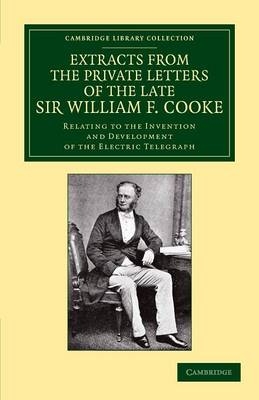
Extracts from the Private Letters of the Late Sir W. F. Cooke
Relating to the Invention and Development of the Electric Telegraph
Seiten
2013
Cambridge University Press (Verlag)
978-1-108-05274-0 (ISBN)
Cambridge University Press (Verlag)
978-1-108-05274-0 (ISBN)
Until the 1830s, the principles of electric telegraphy were confined to laboratories and classrooms. Hoping only to make a hundred pounds, William Fothergill Cooke (1806–79) developed the invention for commercial use. This collection of his letters, which detail the painstaking process of his work, was first published in 1895.
Originally a maker of wax anatomical models, William Fothergill Cooke (1806–79) became aware of the new electric telegraph while he studied anatomy in Germany. Hoping initially for a return of perhaps a hundred pounds from the English railway companies, he abandoned his studies and turned his attention to the commercial development of the technology, which, though demonstrable in laboratory conditions, was still little understood. Because the process relied on secrecy and many different clockmakers and engineers, it soon became so fraught that Cooke almost gave up before its completion. However, after receiving the encouragement of Michael Faraday and joining forces with Charles Wheatstone, Cooke finally brought his plans to fruition and eventually set up the Electric Telegraph Company in 1846. First published in 1895, this book includes a selection of his private letters, written as he worked and often movingly uncertain, as well as a short memoir.
Originally a maker of wax anatomical models, William Fothergill Cooke (1806–79) became aware of the new electric telegraph while he studied anatomy in Germany. Hoping initially for a return of perhaps a hundred pounds from the English railway companies, he abandoned his studies and turned his attention to the commercial development of the technology, which, though demonstrable in laboratory conditions, was still little understood. Because the process relied on secrecy and many different clockmakers and engineers, it soon became so fraught that Cooke almost gave up before its completion. However, after receiving the encouragement of Michael Faraday and joining forces with Charles Wheatstone, Cooke finally brought his plans to fruition and eventually set up the Electric Telegraph Company in 1846. First published in 1895, this book includes a selection of his private letters, written as he worked and often movingly uncertain, as well as a short memoir.
Preface; Extracts; Memoir of Sir William Fothergill Cooke.
| Erscheint lt. Verlag | 21.3.2013 |
|---|---|
| Reihe/Serie | Cambridge Library Collection - Technology |
| Zusatzinfo | 1 Plates, black and white; 7 Line drawings, unspecified |
| Verlagsort | Cambridge |
| Sprache | englisch |
| Maße | 140 x 216 mm |
| Gewicht | 140 g |
| Themenwelt | Geschichte ► Teilgebiete der Geschichte ► Technikgeschichte |
| ISBN-10 | 1-108-05274-6 / 1108052746 |
| ISBN-13 | 978-1-108-05274-0 / 9781108052740 |
| Zustand | Neuware |
| Haben Sie eine Frage zum Produkt? |
Mehr entdecken
aus dem Bereich
aus dem Bereich
Buch | Softcover (2024)
Lehmanns Media (Verlag)
CHF 27,90
Digitalisierung neu denken für eine gerechte Gesellschaft
Buch | Hardcover (2023)
Quadriga (Verlag)
CHF 27,95
Vom Perceptron zum Deep Learning
Buch | Softcover (2022)
Springer Vieweg (Verlag)
CHF 27,95


